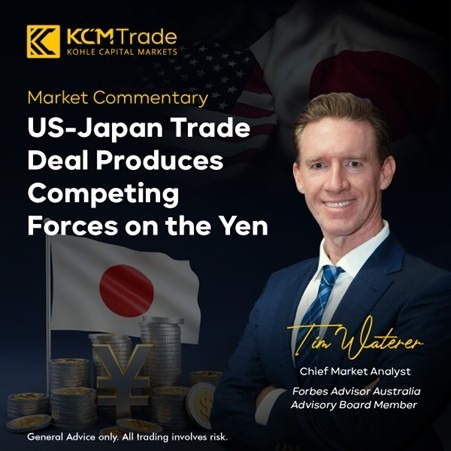By Tim Waterer, Chief Market Analyst of KCM Trade & Forbes Advisor Australia Advisory Board Member
With the August 1st Reciprocal Tariff Deadline fast approaching, President Trump has signed two trade deals this week with the Philippines and Japan which is likely keep market sentiment propped up despite deals with the likes of the EU and South Korea remaining elusive (for now at least).

The US trade with Japan lowers tariffs on Japanese goods exported to the US from 25% to 15%. This lower tariff level boosts the relative competitiveness of Japanese goods and therefore demands for the yen; however, this is offset by expected capital outflows stemming from increased Japanese investments in the US. This is because Japan has committed to investing $550b in the US as part of the deal. The USDJPY rate jumped around in response to the deal with the market digesting the impact of these competing forces on the Japanese currency.
With investors starting to see lower tariff levels on countries which have signed trade deals this week, hopes to remain alive that other countries may soon follow suit which is keeping the market in a cheery mood. Now the wait is on to see if the EU and South Korea can get on board for trade deals by month-end. The Nikkei has been the outperformer today in Asia on the back of the US-Japan trade deal news with traders encouraged by the sight of lower tariff levels as well as the uncertainty which has been removed because of the trade agreement.
Elsewhere, gold is having a good week courtesy of the USD and treasury yields cooling. The Dollar Index (DXY) has slipped 1% this week which has enabled gold to make a run past the $3400 level. Trading at $3430 early Wednesday, next key resistance to overcome sits at $3450, while support is at $3400 and $3368. The 6bp (basis points) fall in the US 10-year treasury yield this week is helping gold from a yield perspective. If further trade deals are signed ahead of August 1st this could further boost general risk appetite and reduce the demand for gold. But if the USD remains pressured this will keep a return to $3500 a viable near-term prospect for the precious metal.
Oversupply concerns and lower geopolitical risks are weighing on the oil price. The move lower in the USD would ordinarily be good for oil but the benefit has not been apparent due to these other factors, particularly with OPEC+ due to ramp up oil production again next month. With US crude trading at around $65.45, resistance sits at $66.30 and $67.35, with support at $64.78. US crude oil inventory figures are due during US trading hours on Wednesday, and if there is a build in inventory numbers this could further pressure the price.
Looking ahead, we have an ECB interest rate decision on Thursday however no rate change is expected. With EU (European Union) inflation sitting just above the target level at 2.3% and EU-US trade relations still up in the air (with no agreement yet reached), the ECB will likely see a rate hold this week as the prudent approach. Particularly with 30% tariffs from the US waiting in the wings from August 1st should a trade deal remain difficult to pin down.
